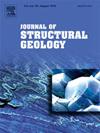美国缅因州沙丘角剪切带重结晶石英团聚体的周长-面积关系中记录的应变速率
IF 2.6
2区 地球科学
Q2 GEOSCIENCES, MULTIDISCIPLINARY
引用次数: 0
摘要
目前可用的方法来确定应变率在粘性变形是有限的,通常依赖于适当的显微结构的保存。确定单矿物石英聚集体应变率的一种鲜为人知的方法是将晶界的周长-面积分形维数(d值)与变形条件联系起来。我们通过将其应用于沙丘角剪切带(SCSZ)来探索这种方法,SCSZ是一个从摩擦-粘性过渡的底部挖掘出来的发震剪切带。d值的应变速率模式与流动规律结合晶粒尺寸压力计的应变速率模式相似,并使用Shimizu(2012)的理论压力计预测了与流动规律的应变速率相似的量级。我们将石英的d值与晶粒形状和晶界粗糙度的代表进行了比较,发现d值与晶粒尺寸之间存在明显的相关性,表明它可能记录了流动应力。我们认为,内剪切带内d值和再结晶粒度的空间变化趋势差异反映了与地震周期相关的瞬态变形事件的影响。虽然d值通常被认为是衡量晶界的锯齿度或粗糙度,但这项研究表明,d值、晶粒尺寸、纵横比和圆度之间存在更复杂的相互关系。鼓励未来的实地工作和实验校准来测试我们的发现并改进从d值得出的应变率估计。本文章由计算机程序翻译,如有差异,请以英文原文为准。
Strain rates recorded in the perimeter-area relationship of recrystallized quartz aggregates from the Sandhill Corner shear zone, Maine, USA
Current available methods for determining strain rates during viscous deformation are limited, generally relying on the preservation of appropriate microstructures. A lesser-known method to determine strain rates of monomineralic quartz aggregates relates the perimeter-area fractal dimension (D-value) of grain boundaries to deformation conditions. We explore this method by applying it to the Sandhill Corner shear zone (SCSZ), a seismogenic shear zone exhumed from the base of the frictional-to-viscous transition. Strain-rate patterns from D-values are similar to those from flow laws combined with grain size piezometry and predict comparable magnitudes to rates from flow laws using the theoretical piezometer of Shimizu (2012). We compare quartz D-values with proxies for grain shape and grain boundary roughness and find a clear correlation between D-value and grain size, suggesting it may record flow stress. We interpret the disparity in spatial trends between D-value and recrystallized grain size within the inner shear zone as reflecting the influence of transient deformation events associated with the seismic cycle. While the D-value is commonly referred to as a measure of the degree of serration or roughness of grain boundaries, this study suggests a more complex interrelationship of the D-value, grain size, aspect ratio, and roundness. Future field work and experimental calibrations are encouraged to test our findings and refine strain-rate estimates derived from D-values.
求助全文
通过发布文献求助,成功后即可免费获取论文全文。
去求助
来源期刊

Journal of Structural Geology
地学-地球科学综合
CiteScore
6.00
自引率
19.40%
发文量
192
审稿时长
15.7 weeks
期刊介绍:
The Journal of Structural Geology publishes process-oriented investigations about structural geology using appropriate combinations of analog and digital field data, seismic reflection data, satellite-derived data, geometric analysis, kinematic analysis, laboratory experiments, computer visualizations, and analogue or numerical modelling on all scales. Contributions are encouraged to draw perspectives from rheology, rock mechanics, geophysics,metamorphism, sedimentology, petroleum geology, economic geology, geodynamics, planetary geology, tectonics and neotectonics to provide a more powerful understanding of deformation processes and systems. Given the visual nature of the discipline, supplementary materials that portray the data and analysis in 3-D or quasi 3-D manners, including the use of videos, and/or graphical abstracts can significantly strengthen the impact of contributions.
 求助内容:
求助内容: 应助结果提醒方式:
应助结果提醒方式:


